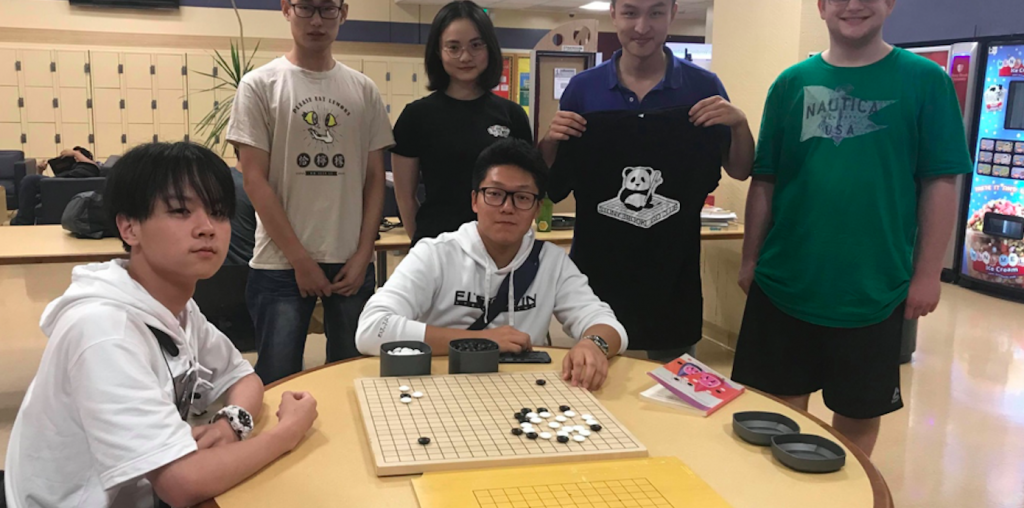The commuter lounge in the Melville Library at Stony Brook University was only half-filled at 7:30 on a Tuesday night. Several students sprawled out on the weathered blue sofas in the middle of the room. Most of the booths by the windows were occupied, but with only one student in each. Their view of the outside was of the path known as the “Academic Mall,” which was nearly obscured by inky darkness — only a few lamps faintly illuminated the walkway, revealing students hurrying to their nighttime classes.
Despite the scarcity of students, the lounge was still somewhat noisy. The indistinct chatter echoed through the lounge and could be heard in the study areas in the hallway. A few computers added to the din. One source of the noise was Stony Brook’s Go Club.
Members of the Go Club were spread among three tables facing a wall of windows. At the far right table, three students huddled over various containers and folders. One young man watched silently as the other two placed black and white pieces on a yellow wooden board. Nobody sat at the middle table, which was a dumping ground for supplies: two more yellow boards, a white plastic bag, various books and a grey backpack. A translucent box of California sushi rolls crowned the mountain of objects. At the far left table, club president Lei Sun and members Batuhan Aykac and Taesik Choi sat around a fourth board discussing strategies for upcoming rounds of Go.
Go, according to the Encyclopedia Britannica, is a two-player board game some experts speculate was created in China nearly 4,000 years ago. The game is played on a board with 19 vertical and 19 horizontal lines using more than 300 small pieces. The pieces are divided by color, with the black half going to one player and the white half going to the other. The two players then take turns placing pieces on the intersections made by the crisscrossing lines. Players work to surround their opponent’s pieces with their own, in order to capture and remove them from the board. The game continues until all the pieces have been used, and the player with the larger number left on the board wins.
Go spread from China to Japan to Korea, and from there to the rest of the world. Japan created the Japanese Go Association in 1924, and Europe founded its European Go Foundation in 1950. International tournaments feature the most skilled Go players facing off in intense contests of strategy. Regional Go organizations host local tournaments and hyperlocal clubs, like Stony Brook University’s Go Club, that attract fans seeking to play the game in a comfortable setting.
Like chess, Go is a game that appears to be simple but actually requires skill to master. The only way to accumulate enough experience to play the game well is to study various methods devised by Go strategists. Players register for a rank, usually based on their level of skill in playing the game, and compete with other similarly ranked players. The highest rank is usually called Dan and is reserved for the most skilled players — but some Go fans prefer to play non-competitively. On that October night in the commuter lounge, Sun and his compatriots were doing just that.
“Play your moves on the second line,” Lei Sun said to Aykac.
Sun’s tall, lithe body towered above the game board, his short black hair faintly illuminated by the overhead lights. He withdrew a hand from his blue over-the-head sweater, reached into two open grey cylinders and gently dropped individual pieces onto the game board. As his hand hovered over the board, he looked down at his iPhone, which displayed an image of a Go game board with pieces on it. Sun explained that the image was a set of diagrams created by artificial intelligence to develop hypothetical Go situations. To learn new strategies, he would place pieces on a physical board, replicating the position of the pieces in the computer-generated diagram, then attempt to solve the problem.
He explained that losing some pieces will be trivial if a player plays like the diagram suggests. “But yeah, I think you can try that. Play safe, though,” he said to Aykac.
Sun grew up in Shanghai, a province of China. In primary school, he was a Go champion. He studied the game for five years and became the most successful player in his class. Sun didn’t touch the game in middle or high school, but when he came to Stony Brook University, he joined the Go club right away.
“I enjoy the sense of being the club president of Go,” Sun said. “Besides that, it refreshes my memory of my childhood.”
Now a senior, he shares his years of experience with his colleagues.
Aykac watched as Sun moved several white pieces on the board. His dark brown hair contrasted with his light grey sweatshirt. Sun’s moving hand was reflected in Aykac’s grey glasses.
“If you do this,” Sun said, “I could attack you.”
Aykac put down his small container of sesame chicken noodles.
“But what about this?” Aykac pointed with a chopstick to nearby black pieces.
“Here?” Sun asked. “I don’t think so.”
He placed a short string of white pieces around the black pieces. The black pieces were now almost entirely surrounded, like Leonidas’ troops at the Battle of Thermopylae. One black piece, however, was not quarantined and remained connected to a nearby string of free comrades.
“Even if I cannot capture you because you have [a connection], I can sacrifice [some of my own pieces],” Sun said casually.
He demonstrated what he meant. The white piece next to the free black piece was soon captured, but in the process, Sun opened more spaces for white pieces to occupy. In the next turn, Sun cut off the black piece’s last means of escape.
Aykac returned to his sesame noodles, scraping his chopsticks against a piece of shrimp pinned to the wall of the container. He remained silent as Sun turned to Choi to show him more strategies.
Aykac became interested in Go when he was 13. While surfing the Internet, he found articles about the game and developed a passion for it. He joined the Go club at Stony Brook when he was a freshman. By now, he’s been playing in the club for a month.
“I play it a good amount. Almost ten hours a week is just Go,” Aykac said.
Aykac grew up in Hampton Bays, on the East End of Long Island. Every summer, until 2016, he visited relatives in Istanbul, who lived near the mansion of Turkish President Recep Tayyip Erdogan.
“In 2016, I got bombed in Turkey,” Aykac said matter-of-factly.
That summer, Aykac had been relaxing in his relatives’ home when the ground trembled. A place down the street had been bombed. Another explosion detonated shortly afterwards. The bombings were part of an unsuccessful military coup d’état against Erdogan on July 15, 2016 — an attempt that ended in hundreds of deaths and arrests. Within days, the BBC reported the Turkish government had arrested nearly 6,000 people, and CNN reported at least 290 people had been killed, with more than 1,400 reported casualties.
The calm, almost tranquil nature of the university commuter lounge couldn’t have been more drastically different from the constant sound of explosions and gunshots in Turkey.
Aykac said he enjoys the Go club because “it’s a nice atmosphere.” “It’s fun to have a break and play Go,” he said.
He finished the sesame chicken and tucked the container into his black backpack. He then rested his chin on his hand while watching Sun converse with Choi.
While Sun was showing Choi a strategy, a student named Yuxuan Yu joined the group. Broad-shouldered and wearing a grey shirt, Yu stood behind Sun, his slightly puffy black hair sticking above Sun’s head. Sun replicated a board layout from a diagram on the board, placing several strings of black and white pieces next to each other on the board.
“Maybe you don’t want to cut like this,” Sun explained, referring to the black line. “Because then you’re in trouble.”
Yu rearranged some of the white pieces to leave a couple of openings.
“Is that better?” he asked.
“Yeah,” Sun replied.
“Is there an easier way out of this situation?” Choi asked.
Choi was slightly shorter than Sun, but also had black hair. He took off a pair of glasses and put them inside his blue hoodie as he looked at Sun’s new arrangement of pieces.
Choi, also a senior at Stony Brook, was born in South Korea. His father had trouble securing a steady means of income, so Choi and his family moved frequently. As he moved from school to school, he developed an interest in gonggi, a children’s game in which the players throw rocks, called gonggitdol, in the air and attempt to catch them with the backside of their hands. When a girl stole his gonggitdol, he was afraid to ask for it back lest she feel uncomfortable. It was then that he picked up Go.
Choi said he liked the game because he enjoys playing with other people. “I really love to play with stronger players because I can learn something from them,” he said, adding that one of his goals is to be a professional Go player.
Choi joined the Go club the same semester as Aykac. He looked up to Sun because Sun is a high-ranking player, and he watched Sun’s every move.
Sun demonstrated a possible way for Choi to escape the situation he had replicated on the board. He tapped a specific point nearby on the board and looked at Yu, who placed a black piece on that point. Three white pieces were added in a line below the black piece, as well as two pieces just to the right of it. Sun put two black pieces underneath the first white piece and to the right of the other black piece, blocking off most of the white pieces. The piece southernmost of the original black piece was joined by a white piece, only for its companion to be blocked. The white enemy had been trapped.
Choi nodded but didn’t say a word.
A few minutes later, Sun brought up yet another diagram and rearranged the pieces on the board. Now, a line of white pieces curved through a maze of black pieces. Sun and Yu whispered to each other, then Yu added new pieces to better match the diagram. Sun turned to Choi.
“And then you connect here,” he said to Choi, pointing at one end of the white snake. He added a black piece, suffocating the snake in a sea of black.
“That’s a messy coup,” Choi said.
“Yeah, it’s messy.”
As the Go Club developed new strategies throughout the night, the Commuter Lounge emptied out. Some students who had fallen asleep on the blue sofas woke up to the sound of their ringing iPhones and slowly grabbed their belongings and walked out. Go Club meetings officially end at 10:30 p.m., since some of the games can be long and intense. But the players don’t mind. All they want to do is sit down, chitchat and play Go.




Comments are closed.